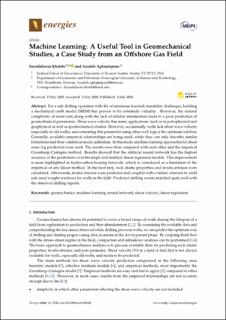| dc.contributor.author | Khatibi, Seyedalireza | |
| dc.contributor.author | Aghajanpour, Azadeh | |
| dc.date.accessioned | 2022-09-02T09:35:43Z | |
| dc.date.available | 2022-09-02T09:35:43Z | |
| dc.date.created | 2021-02-01T12:20:03Z | |
| dc.date.issued | 2020 | |
| dc.identifier.citation | Energies. 2020, 13 (14), . | en_US |
| dc.identifier.issn | 1996-1073 | |
| dc.identifier.uri | https://hdl.handle.net/11250/3015355 | |
| dc.description.abstract | For a safe drilling operation with the of minimum borehole instability challenges, building a mechanical earth model (MEM) has proven to be extremely valuable. However, the natural complexity of reservoirs along with the lack of reliable information leads to a poor prediction of geomechanical parameters. Shear wave velocity has many applications, such as in petrophysical and geophysical as well as geomechanical studies. However, occasionally, wells lack shear wave velocity (especially in old wells), and estimating this parameter using other well logs is the optimum solution. Generally, available empirical relationships are being used, while they can only describe similar formations and their validation needs calibration. In this study, machine learning approaches for shear sonic log prediction were used. The results were then compared with each other and the empirical Greenberg–Castagna method. Results showed that the artificial neural network has the highest accuracy of the predictions over the single and multiple linear regression models. This improvement is more highlighted in hydrocarbon-bearing intervals, which is considered as a limitation of the empirical or any linear method. In the next step, rock elastic properties and in-situ stresses were calculated. Afterwards, in-situ stresses were predicted and coupled with a failure criterion to yield safe mud weight windows for wells in the field. Predicted drilling events matched quite well with the observed drilling reports. | en_US |
| dc.language.iso | eng | en_US |
| dc.publisher | MDPI | en_US |
| dc.rights | Navngivelse 4.0 Internasjonal | * |
| dc.rights.uri | http://creativecommons.org/licenses/by/4.0/deed.no | * |
| dc.title | Machine learning: A useful tool in geomechanical studies, a case study from an offshore gas field | en_US |
| dc.title.alternative | Machine learning: A useful tool in geomechanical studies, a case study from an offshore gas field | en_US |
| dc.type | Peer reviewed | en_US |
| dc.type | Journal article | en_US |
| dc.description.version | publishedVersion | en_US |
| dc.source.pagenumber | 15 | en_US |
| dc.source.volume | 13 | en_US |
| dc.source.journal | Energies | en_US |
| dc.source.issue | 14 | en_US |
| dc.identifier.doi | 10.3390/en13143528 | |
| dc.identifier.cristin | 1884961 | |
| cristin.ispublished | true | |
| cristin.fulltext | original | |
| cristin.qualitycode | 1 | |

